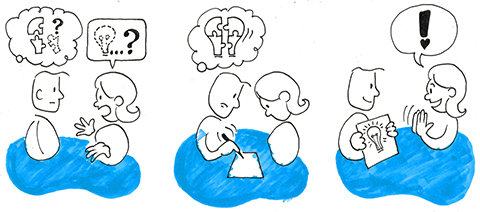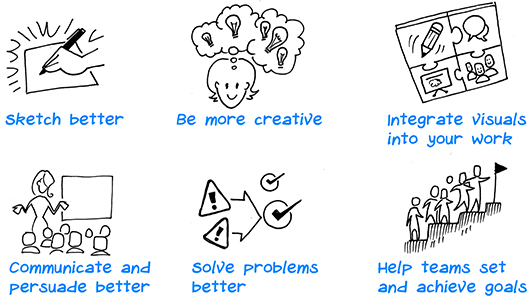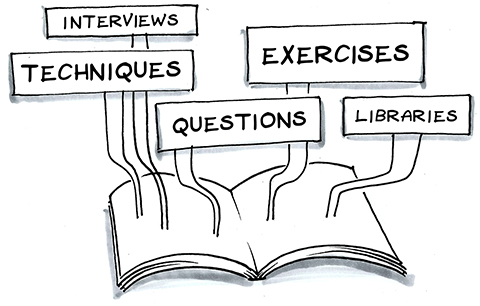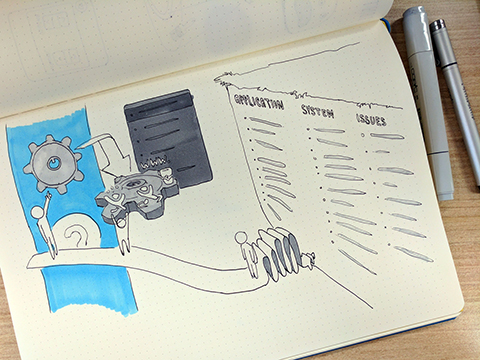Chapter 1. Introduction

BORING MEETINGS. LONG, DENSE business presentations. Foggy strategy. Lame ideas. Confused teams. You’re about to kiss all those goodbye, by becoming a Presto Sketcher.
Presto Sketching is a clever way of using simple drawing to better explore problems, better explain concepts, and better envision new ideas. I’ve helped loads of product teams and managers use simple sketching in these ways, and I’ve been teaching these methods for years. All of them have discovered the sheer unbridled magic that sketching can bring to their work and their lives, and now it’s your turn!
In this introduction, I’d like to show you a few things:
That you’re about to discover (or rediscover?) how sketching is the gateway to better thinking
What you’ll get from this book (and what you won’t)
How to use the contents of this book to hone your sketching skills in the best way
Sketching: Your Untapped Superpower
You’re probably thinking that this is a book about sketching. And it is. I want to help you be a better sketcher. I want to help you be more confident in bringing what is in your head out onto paper and into the world.
But I also want to show you how sketching is one of your greatest untapped superpowers, not just because sketching looks great, but because the very act and process of sketching makes you smarter. By developing your sketching superpower, you will think more clearly and strategically, you will solve problems better, you will have more ideas, and you will be a better communicator. And in doing that, you’ll bring real magic into others’ lives by helping them with their thinking, their ideas, and their plans.
But I’m getting ahead of myself. Let’s get into why this book is for you, and what Presto Sketching will do for you.
Wait, There’s More Than Just Sketching Wireframes?
When I was a kid, I was always fascinated by magicians and how they could quite literally produce a dove or some other thing out of thin air, all in a quick flourish.
Sketching is definitely a kind of magic, too. All forms of visual art can cast a spell on us, drawing us in, challenging us, soothing us, making us reflect, changing our view of the world. A study by the Art Gallery of New South Wales in Australia found that viewing art helped people with dementia deal with anxiety1 because art kept them in a state of “in the moment pleasure,” or what author Mihaly Csikszentmihalyi would call “flow.”2 Art sneaks up on us and helps us tap into our imaginations, which is a funny sensation for most people. There are some works of art I could sit in front of for hours, they have such an effect on me.3
But there’s also definitely something magical about seeing something come to life as someone draws it, before your very eyes. And it doesn’t matter what the level of drawing ability is: watching someone else draw is a magical experience. That’s why Pictionary is such an endearing game; it’s just so much fun to watch other people draw!4
This kind of magic happens to work amazingly well in our working lives, when we combine words and sketching (Figure 1-1) in meetings and workshops. The shared experience of turning a jumbled conversation into a crisp sketched image on a whiteboard is nothing short of extraordinary. That’s synthesis in action. It’s like a wizard reaching into your brain, lifting out a bunch of half-formed ideas, and breathing life into them before your very eyes, all with a flourish of the whiteboard marker and a doff of the pointy hat.

Figure 1-1. Words and sketching are better together: There’s real magic in listening to what someone describes verbally, and then reflecting that as a clear, compelling sketch.
That’s what Presto Sketching is all about: using sketching for clever thinking as well as clever communication; expressing yourself and your ideas to others through light, simple drawing; and helping others think and express themselves in the same way.
There is so much more that you can sketch as a designer, product manager, or entrepreneur than just user interface wireframes. Presto Sketching is about letting your hand do more of the talking. It is such an amazing way to conjure a concept, bring something to life in seconds, bring clarity to something that’s wordy and vague—all with a super simple drawing!
How This Book Will Power Up Your Product Thinking and Design
If you’re reading this right now, I figure you’re interested in getting better at sketching to help you think, work, or be creative in some way. Hurrah! No matter what you think your drawing ability is, no matter how “visual” you think you are, this book will help you in lots of areas (Figure 1-2), wherever you’re at in your sketching journey.

Figure 1-2. What you’ll get from this book: How sketching will improve your product thinking and design.
If you’re fairly new to the world of visual thinking and visual communication, Presto Sketching will set you up for success. By putting the techniques in this book into practice, you’ll be well on your way to seeing these results:
Greater confidence and enjoyment in sketching and adding your own images to your work
A greater variety and number of ideas and solutions to problems
More dynamic and persuasive presentations, reports, and other communications
Expanding your professional skill set to include visual thinking and visual communication
More effective and insightful meetings
Being known as a more creative, innovative person
What You Won’t Get from This Book
I should be up-front and say that if you’re after a book to help you in the full range of drawing techniques, this isn’t the book for you. Presto Sketching is about showing people your ideas in progress, not showing them beautiful finished pieces of art. It’s also about helping people to see themselves in whatever situation you’re sketching, not just what you think about that particular situation.
So, we won’t be going into topics like these:
How to do perspective and fancy orthographic views
How to do portraits, still-life compositions, landscapes, and so on
How to become famous as an artist
That said, if you’re a student of creative and aesthetic practice, I’m sure you’ll find some gems here to take into your own artistic journey. I’ve been teaching techniques like these for years; every class contains a range of abilities and levels of confidence, and everyone always extracts something rewarding and useful from them.
Using This Book
This book has three major sections. The first section (Chapter 2 to Chapter 4) will help you understand the place that visual communication has in your work and how to gain confidence in being a producer—not just a consumer—of visual communication.
The second section (Chapter 5 to Chapter 9) is chock-full of techniques, tips, and tricks to give you a foundation that you can adapt to your own work. The third section (Chapter 10 to Chapter 14) helps you apply these techniques in specific areas of product strategy, management, and design.
Each chapter has some exercises to help you put the lessons and techniques learned into practice. The exercises build on one another and become more difficult, but also more fulfilling and more Instagram-worthy. You’ll notice that each one has a difficulty setting. This is also a great way to dip into the book from time to time, depending on where you’re at.
Most chapters end with some questions to help you consider your progress and establish where you want to go in your sketching journey. Treat them as mentoring tools, to help you stretch yourself where you want to be stretched. No matter where you are on that journey, I guarantee you that there are ways you can stretch yourself, whether by honing your execution, influencing others, getting out of a rut, or trying new things.
You’ll also find some interviews with different people throughout the book. Each person is at a different stage in their journey of visual practice, but their stories are all fascinating, as are the individuals behind them. I’ve been greatly inspired by them, and I hope you are, too.
And if all the techniques, exercises, questions, and interviews (Figure 1-3) aren’t enough, there are also some libraries of different images to help you along, such as icons, visual metaphors, and conceptual illustration patterns.

Figure 1-3. What’s in this book: You can dip into any part of Presto Sketching to pick up tips on technique, exercises, questions, interviews, and libraries of various types of sketches.
Enjoy the Ride
Presto Sketching is going to take you on a journey into your own thinking and creativity as well as into a larger world of visual thinking and visual communication. I’ve enjoyed this ride immensely in my own life and seen so much benefit from it; I hope that it helps you and expands your world, too.
I’m often reminded of the notion that you don’t need to change the world, you just need to change the world for the person in front of you, and that’s okay. Perhaps sketching can help you change how you see a problem, think up solutions, communicate your ideas, and reimagine your world. If you do that, you can in turn help that person in front of you, that team meeting, that room of people to see a problem, think up solutions, communicate their ideas, and reimagine their world.
Let’s go.
Some Questions for You
What are your goals?
What would you actually like to achieve, when it comes to sketching? What would you personally like to get out of reading this book? Write down three goals you have, and keep them together with your aforementioned first sketch of how to make a pizza.
You might not have any specific goals at this point, and that’s fine. Here are some examples that might help:
To increase my drawing ability, beyond just being able to draw a random box and stick figure
To boost my confidence in sketching in front of others
To use whiteboard drawing more in my meetings at work
Interview with Alex Riegelman
Alex Riegelman started as an industrial designer and is now a lead designer at Atlassian, where he applies conceptual modeling to solving complex problems. We all might not have Alex’s industrial design drawing chops, but anyone can take on his approach to using sketching as a way to sell ideas.
AR: The thing that I really enjoy about design is thinking about big complex systems with lots of moving parts; that’s what gets me out of bed in the morning. I take a perverse satisfaction in trying to hold in my mind how all those parts fit together. It’s one of my strengths as a designer. Visual design? Not so much.
The work that I’ve been doing for the last year is not about the details of interfaces or buttons or pages, but how we can change the whole conceptual model, to improve the software. I need the buy-in of 20 or so stakeholders who know what they have and who are skeptical of change, and I have to convince them somehow to devote time and resources to make this change.
I find sketching really valuable for communicating that kind of complex idea. Simplifying all those parts and connections I hold in my head to provide a shortcut for people like those stakeholders, who don’t have the same desire, capacity, or time.
You can always draw boxes and arrows, but when things get to a certain scale and complexity, boxes and arrows lose their ability communicate; it just looks like a giant lot of spaghetti. It can also be tempting to show lots of wireframes, but it’s still asking the audience to hold too much in their head. You need some level of synthesis or abstraction on top of a strictly representative diagram, and you need to use sketching to convey emotion. Start with, “Here’s how it feels.” I’ve been having more and more success with that.
If I were to draw a diagram of a system before and after a proposed change, and the second drawing has 20 percent fewer boxes and arrows, everyone will shrug and say “Yeah, that one has 20 percent fewer boxes...” but they won’t emotionally connect with it.
It’s important to match the medium to the audience. Sometimes a sketch in a sketchbook is enough. I can bring it out from time to time in conversation and use it to say, “If we do that, this is the emotion that customers will have,” or “This is a possible future that we may end up with.” That works if it’s a small group of people. But if it’s going really broadly, I’ll polish it in Illustrator. If it’s just a hand-drawn sketchy thing, it’ll only suit people who are in the problem, and who communicate that way, too, because they accept that the sketch—and the thinking—doesn’t feel finished. But if I polish it, it conveys a level of confidence. People are more willing to accept that this person (or group) has done the work to understand and solve the problem, because what they’re viewing has the appearance of being complete, just like the thinking behind it is complete.
I like to use a lot of visual metaphor in my work, especially ones that are grounded in a three-dimensional space. This is probably because of my education as an industrial designer. I’m all about the physical world. It’s a universal reference, everybody lives in the physical world, so everyone can relate. If I want to convey a huge challenge, I sketch a cliff. But it’s a cliff that is in three-dimensional space; you can’t get over it (Figure 1-4). It’s somehow more resonant than just showing two-dimensional icons or objects floating around in space.

Figure 1-4. Alex on adding impact with visual metaphor and 3D space: “I like to use a lot of visual metaphor in my work, especially visuals that are grounded in a three-dimensional space.”
Even if sketching is not something that you enjoy doing, there are people who learn best through this kind of communication. Even if it’s not your forté, it can be a really powerful way to communicate with others. And if you can combine visual communication and writing into an activity, that’s even better!
Start with, “Here’s how it feels.” I’ve been having more and more success with that.
1 For more on this study, see Stephanie Dalzell’s article, “Art alleviates anxiety for people with dementia, new research finds,” available at http://ab.co/2cX99bI?.
2 See his book Flow: The Psychology of Optimal Experience (Harper Perennial Modern Classics).
3 “Pan” (1898) by Australian artist Sydney Long comes to mind. It’s a vision of Arcadian bliss, bathed in low twilight. It gives the rugged Australian landscape a more mythical, ethereal character, with the trees appearing to wave and waft in surreal shapes like smoke. I could go on about this painting for ages!
4 Personally, I love those times playing Pictionary when the person drawing renders the clumsiest thing ever, and their partner guesses it straight away, leaving an opponent—who’s known to be really good at drawing—utterly dumbfounded!
Get Presto Sketching now with the O’Reilly learning platform.
O’Reilly members experience books, live events, courses curated by job role, and more from O’Reilly and nearly 200 top publishers.

